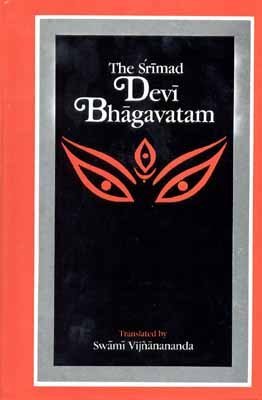The Devi Bhagavata Purana
by Swami Vijñanananda | 1921 | 545,801 words | ISBN-10: 8121505917 | ISBN-13: 9788121505918
The English translation of the Devi Bhagavata Purana. This Sanskrit work describes the Devi (Divine), the Goddess, as the foundation of the world and as identical with Brahman, the Supreme Being. The Devi Bhagavata Purana is one of the most important works in Shaktism, a branch of Hinduism focusing on the veneration of the divine feminine, along w...
Chapter 12 - On the narration of Plakṣa, Śālmala and Kuśa Dvīpas
1-37. Nārāyaṇa said :-- The Jambudvīpa has been described, how it is and what is its width. It is surrounded on all sides by the salt ocean. As Meru is surrounded by Jambudvīpa, so the salt ocean is surrounded by Plakṣadvīpa, twice its size. As the ditch is surrounded by gardens, so the salt ocean is surrounded by gardens. As the Jambu tree exists in Jambudvīpa, so the Plakṣa tree exists in the Plakṣa Dvīpa and of the same size. The name Plakṣa Dvīpa is derived from the name of this Plakṣa tree. This tree is of a golden colour. Fire exists at its bottom with form incarnate. This is, named Saptajihva. The Ruler of this island is Idhmajihva, the son of Priyavrata. He divided his island into the seven Varṣas and distributed them, to each of his seven sons and he himself took refuge of the path of Yoga, so much liked by the Knowers of Self and he got the Bhagavān Vāsudeva.
The names of those seven Dvīpas are :-- Śiva, Yavas, Subhadra, Sānti, Kṣema, Amrita, and Abhaya. Seven rivers and seven mountains exist respectively in the seven islands.
The rivers are :-- Aruṇā, Nrimnā, Aṅgirasī, Sāvitrī, Suprabhātikā, Ṛtambharā, and Satyambharā. The names of the mountains are Maṇikūta, Vajrakūta, Indrasena, Jyotiṣmāna, Suparṇa, Hiraṇyasthīva, and Meghamāla. The seeing and drinking the waters of these rivers take away all sins and all darkness due to ignorance. The four castes live here, Hamsa, Patanga, Ūrdḥāyana, and Satyāṅga, corresponding to the four castes Brāhmaṇa, etc. The inhabitants of this Plakṣa Dvīpa live for one thousand years and all are of variegated wonderful appearances. They follow the customs and usages dictated by the Vedas and worship the God Sun for the attainment of Heaven.
The mantra by which the worship is done is this :-- We take refuge unto that Sun, Who is the Body Manifest of the Ancient Person Viṣṇu and Who is the Ordainer of Satya (Truth), Ritā (Straight forwardness), Brahmā, Amrita (Immortality) and Mrityu (Death); O Nārada! All the persons here live long, of vigorous senses, energetic, powerful, intelligent, enthusiasts, and valorous; everyone gets extraordinary powers of themselves. Next to this Plakṣa Dvīpa is the Ikṣu Ocean. This Ikṣu Sāgara surrounds the Plakṣa Dvīpa. Next comes Śalmala Dvīpa. It is twice as large as Plakṣa. This Dvīpa is surrounded by Surāsāgara (the ocean of wine). There is a tree named Śalmalī in this island, which is as large as the Plakṣa tree. The high-souled Garuḍa resides on that tree, Yajñavāhu is the Ruler of this place. He was born of Priyavrata; he divided his Varṣa into the seven parts and distributed each of them to his seven sons respectively.
Now hear the names of these Varṣas :-- Surocana, Saumanasya, Ramaṇa, Deva Varṣa, Pāribhadra, Āpyāyana, and Vijñāta. Seven mountains and seven rivers exist there respectively.
The names of the mountains are :-- Sarasa, Śataśriṅga, Vāma Deva, Kandaka, Kumuda, Puṣpavarṣa, and Sahasra-Śruti. Now hear the names of the rivers. Anumati, Sinībālī, Sarasvatī, Kūhu, Rajanī, Nandā, and Rākā; these are the seven rivers.
The people are divided into the four castes :-- Śrutadhara, Vīryadhara, Vasundhara, Iṣundhara. These correspond to the Brāhmaṇas, etc. They worship the Bhagavān Moon, the Controller of all and the Creator of all the Vedas. They offer food duly in the black and white fortnight to their Pitris.
The mantra for their worship is :-- “Let Soma, the King of all, be pleased.” O Nārada! Next to Surāsāgara is Kuśadvīpa, surrounded by Ghritasāgara (the ocean of clarified butter). Its dimensions are twice as large. Here are blades of Kuśa grass, of a very resplendent colour. The name of the Dvīpa is from this Kuśastamba. This bundle of Kuśa, illumines all the quarters with their gentle rays. The Ruler of the Dvīpa is Hiraṇyaretā, the son of Priyavrata. He divided the Dvīpa into seven parts and distributed each of them to each of his seven sons respectively.
The names of the seven sons are :-- Vasu, Vasudāna, Dhriḍharuci, Nābhigupta, Stutyavrata, Vivikta, and Bhāmadevaka. There are seven mountains forming the seven boundaries and so are the seven rivers. Hear the names of these.
The names of the mountains are :-- Cakra, Catuhśriṅga, Kapila, Chitre Devānīka, Kūta, Ūrdharomā and Draviṇa.
The names of the rivers are :-- Rasakulyā, Madhukulyā, Mitravindā, Śrutavindā, Devagarbhā, Ghritācyut, and Mantramalikā. The inhabitants of the Kuśadvīpa drink the waters of these rivers. There are the four castes here Kuśala, Kovida, Abhiyukta, and Kulaka corresponding to the Brāhmaṇas, etc. They are all powerful like Indra and the other chief Devas; and all of them are omniscient. They worship the Fire God and perform various good works in honour of Him.
Their mantra is this :-- O Fire! Thou carriest the oblations direct to Para Brahmā. In the sacrifices of the Devas, Thou worshippest that Personal God and offerest to Him whatever are given in oblations, mentioning the respective limbs of His Body. Thus the inhabitants of that Dvīpa worship the Fire God.
Here ends the Twelfth Chapter of the Eighth Book on the narration of Plakṣa, Śālmala, and Kuśa Dvīpas in the Mahāpurānam, Śrī Mad Devī Bhāgavatam, of 18,000 verses, by Maharṣi Veda Vyāsa.
